RECOMMENDATIONS
FOR
CLIMBING
EQUIPMENT
Recommendations for gear is
subjective, however, there are a number of questions each year on what
kind of gear should you buy so this guide is to steer you in the right
direction. While the choice
of gear may be subjective
there are some mistakes that should be
avoided. What we do in the AMC is
called "trad" (traditional) climbing and gear for other types of
climbing (gym, bouldering, sport, aid) may not be appropriate for use
and you don't want to rely on the salesperson in the local
REI or gym who may climb 5.11s in the rock gym but has never
been on a multi-pitch route.
HARNESS
I recommend a harness with a belay loop and gear loops. Fit is the most important criteria. Adjustable leg loops are recommended if you plan on ice climbing. The Black Diamond Momentum harness is a good buy at around $55 or a Petzl Corax LT at around $65.
SHOES
1) You should buy a pair of fairly stiff lasted "all around" shoes that feel COMFORTABLE. Don’t get them too tight. The shoe should fit snugly and your toe should lie flat in the shoe and not be curled up. You will not climb harder with your toes torqued into a painful bend. In fact you may climb worse because all you are thinking about is getting the damn shoes off. And you will avoid hammer toe, black toenails and other unpleasantries after years of climbing.
2) Don’t listen to anyone about what brand/model to get. The three most important things are fit, fit, and fit. Different people have different shaped feet and different manufacturers cut their shoes differently; Scarpa are cut narrow, 5/10 cut wide, etc. Go to a climbing shop and try-on lots of different brands/models. Buy the shoes that fit you and are designed for the type of climbing you do.
3) Don’t worry about what kind of rubber the shoe uses. There have been several independent tests done by the climbing magazine and they found no discernable difference in “stickiness” between types of rubber on climbing shoes. The only thing they found was some rubber is softer than others and wears out faster. Some shoes have thinner rubber especially at the mid sole and conform to your foot better and this is mistaken for better stickiness.
4) Don’t listen to the salesperson in the outdoor shop/climbing shop/rock gym. They may have been climbing for a few months in the gym and they are an “expert.” You are the expert on how they fit.
CARABINEERS (BINERS)
You
will need one
pear-shaped locking biner for belaying and two smaller
general purpose locking biners. Recommend getting screwgate
biners and not autolocking
biners.

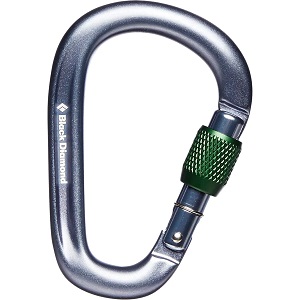
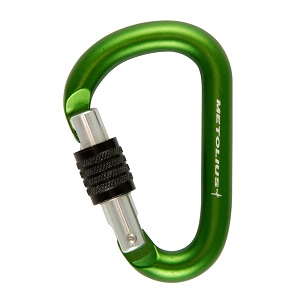
BELAY
DEVICE
There are a slew
of
different belay devices on the market. While any tuber style
belay
device is acceptable the ones with "teeth" have been shown to hold
falls better e.g. Black Diamond ATC-XP. If you plan on going
on
to lead you can
buy a belay device that will serve the function of
belaying a second from above. The ATC-XP-Guide is a common
one. Others are te DMM Pivot and Petzl Reverso. A better
option is a Petzl GriGri but not as a beginner first belay device. If
you are
already familar with the Petzl GriGri and can competently lead belay
with it than it is fine to use that but you will also need a tube
style device (e.g. ATC) for rapelling.
We do not use Figure 8 belay devices
because they are too dynamic and do not lock off with enough
force.

6mm SLINGS
(for Autoblock and Prusik hitches)
This
is a 6mm nylon cord tied in a loop with a double fisherman's knot.
It is used in the Beginner Class as an autoblock and in the
Intermediate Class as a Prusik. For the Prusik you need two
lengths of 6mm nylon accessory cord. One should be 65 inches
long and the other 50 inches long. These should be nylon (Perlon) cord and not high-tech,
high-strength cords like Spectra, Gemini, or Vectra
which are too stiff.
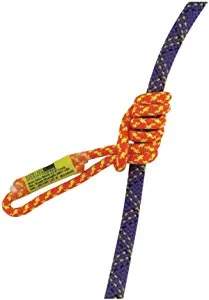
SLINGS/RUNNERS
Get one 2 ft and
one 4 ft sewn slings. These can be nylon (left) or the thin Spectra/Dyneema slings (right).
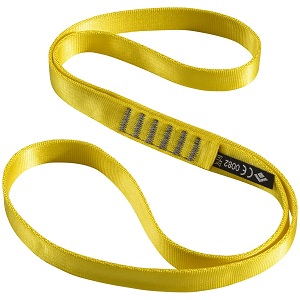 |
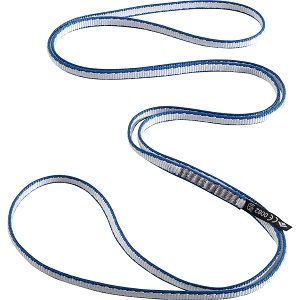 |
NUT-CLEANING
TOOL
Any kind but
the ones with the built in biner
are handy for
clipping.

HELMET
HEADLAMP
Headlamps are required for the
climbing trips. Sooner or later you
CHALK BAG
While
any bag will work this is your one and
only chance at making a fashion statement with climbing gear.
ROPE
You won't need a rope unless you want to venture out on your own after the classes. You can buy a class rope and the end of the course at half the price the AMC paid for it. If you get your own I recommend a 9.5mm to 10mm x 60-meter non-dry rope for top-roping and seconding. If you plan on ice climbing right away then buy a dry rope. When you start leading you'll want to upgrade ropes and then you can read the reviews in climbing magazines or talk to experienced climbers.
GEAR TO
SET UP TOP ROPES
At some point (after the classes and
after
you
WHERE TO BUY YOUR ROCK CLIMBING
EQUIPMENT:
There is a listing of local shops on www.climbri.org . The Rock Spot climbing gym offers a 15 percent discount to AMC class members.
ANYTHING
ELSE?
The Rock Climbing AMGA Single Pitch Manual is what we base instruction on. You can get one online or in climbing shops/gyms. Also most local climbing is in Connecticut so you may want. Rock Climbing Connecticut 2nd ed. by David Fasulo.